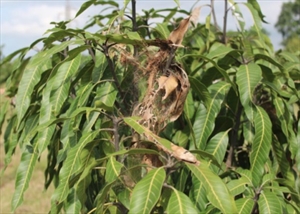- Widespread distribution. On mango, other fruit trees, ornamentals, and weeds. Probably important, but several webworms on mango.
- Larvae web together flowers, young fruits and leaves; leaves rolled and larvae feed from inside.
- Eggs on undersides of leaves; larvae yellowish green, with heads and first two pairs of legs black. Adults pale brown with dark markings, up to 20 mm long.
- Natural enemies: not recorded in Pacific islands (but assumed present).
- Cutural control: prune trees giving sprays better access.
- Chemical control: use Bt (Bacillus thuringiensis): ensure good coverage of shoots and flowers; treat when larvae small, and when webbing first seen. Avoid pyrethroids and organophosphates: they will kill natural enemies.






